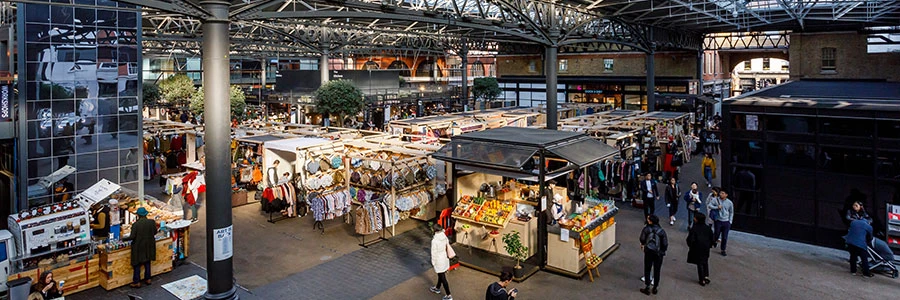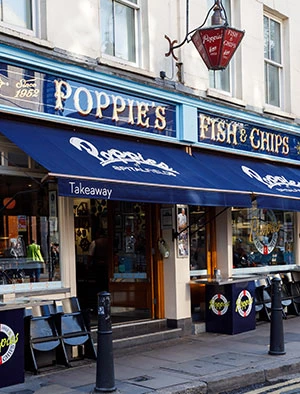Get an instant valuation here or contact one of our offices


Spitalfields in East London has a rich market history dating back to the 17th century and includes Spitalfields Market, Old Spitalfields Market and Petticoat Lane. Yet the old and the new stand side by side in this area, with contemporary steel and glass office blocks springing up beside Victorian railway arches, where über-trendy hipster bars compete with traditional east London boozers and pristine, pedestrianized public spaces lead to winding back streets and alleys reminiscent of Dickensian times.
The community here has an inclusive, multicultural vibe, along with a restless energy, which makes living here feel like you’re part of something new and exciting. From trendy pop-ups and cutting-edge art to stylish new hangouts and secret speakeasies – Spitalfields really has it all going on, meaning there’s plenty to see and do seven days a week, and all of it on your doorstep.
Property in Spitalfields is among the most desirable in the capital and includes impressive warehouse loft conversions, luxury high-rise apartments, imposing Georgian townhouses and blocks of council flats.
Like it’s Shoreditch neighbour, Spitalfields is a magnet for young creatives and city workers. However, families also thrive here. Although Spitalfields doesn’t have a named railway station, you can easily travel from Aldgate East on the Hammersmith & City and District lines or Liverpool Street on the Metropolitan, Hammersmith & City and Circle lines. Shoreditch High Street, Hoxton and Whitechapel are all on the London Overground East London line, and are within easy walking distance.
There’s a surprisingly good choice of schools in the area, with a six primary and two secondary nearby. Of the primary schools, Thomas Buxton is rated outstanding by Ofsted, while at Secondary level the Mulberry Academy also gets an outstanding rating.
Of course a trip to Spitalfields Market is a must. Located on Bushfield Street, we reckon this is one of east London’s finest markets, selling everything from food and fashion to collectables and curios, with music and entertainment thrown in for good measure. And that’s not all, because the market is also home to a wonderful array of independent shops and boutiques, plus plenty of eateries and bars for when you’ve had your fill of retail therapy. You might also happen upon an event whilst visiting here, as the market regularly hosts shows, performances and a lot more besides, all celebrating the area’s rich cultural diversity. Past events have included art exhibitions, tea dances, salsa, street food festivals and pop up theatre, so you never know what you’ll stumble upon!
Despite being much smaller than its sister market, Old Spitalfields Market, a Victorian indoor market, packs a powerful retail punch that belies its size. This is home to one of the best known arts, antiques and fashion markets, as well as showcasing upcoming talent in the creative industries with regular displays and art installations.
For fine dining in an incredible setting, head to Galvin La Chapelle on Spital Square, a Michelin-starred French restaurant that occupies St Botolph’s, a former Victorian school hall with the most amazing Gothic architecture. The fact that this gem of a building still stands is thanks to its supporters and trustees staging a sit in some 40 years ago, when the bulldozers arrived to begin demolition. Thank goodness it was called off, because dining on Chris and Jeff Galvin’s sublime cuisine in such a wonderful setting has got to be up there as one of London’s, if not the world’s, best gastronomic experiences. However, should you prefer something a little more low key, then those Galvin brothers can supply that too, in the form of Galvin Bistrot & Bar, also on Spital Square. Here you’ll be transported to the intimate bistrots of Paris and Lyon, serving flavoursome French classics at reasonable prices.
For a true authentic east London experience, however, it’s got to be Poppies Fish & Chips on Hanbury Street. This great retro diner and takeaway is filled with vintage memorabilia, with the staff all dressed in 50s style uniforms while music from that era is played in the background. The fish here doesn’t come any fresher, coming direct from Peterhead in record time and prepared on site by their very own fishmonger. This is the flagship shop of Pat ‘Pop’ Newland (you’ll also find a Poppies in Camden and Soho), who started his career in 1952 at the tender age of 11, working at a fish and chip shop on the Roman Road where he cut up the newspapers to wrap the fish and chips in!
508 Roman Road
Bow
London
E3 5LU
020 8102 1236
london@butlerandstag.com
Spitalfields is named after the St Mary Spittel hospital and priory that was located there. Known throughout the years for its strong sense of community, it is thought that this stems from the infectious closeness and solidarity that the Spitalfield Market traders demonstrated when they started to meet on the field next to the Priory in the 13th century. The market attracted visitors, traders and residents from a range of different cultures and communities, all adding to the melting pot of its identity.
Spitalfield remained a primarily rural location until the Great Fire of London pushed market traders further afield, to the location where it stands today thanks to John Balch being granted a Royal Charter by King Charles II to hold a market near Spital Square on a Tuesday Thursday and Saturday.
The market became the focal point of Spitalfields and thanks to its continued success it acted as a magnet attracting many settlers to the area. By 1685 news of the market, its reputation, lack of Guild scrutiny and the cheaper cost of food and living had spread and following the retraction of the Edict of Nantes in what was at the time Catholic France, some 40,000 – 50,000 Protestant Huguenots fled and upon arrival in England, a large number headed for Spitalfields. The Huguenots were talented silkworkers and weavers and their arrival hugely increased the profile of the area and what it had to offer leading it to become known as “weaver town”.
The Huguenot’s other great impact on Spitalfields was through the formation of their Protestant churches. Within five years of their arrival, nine churches were founded in the area and although their loyalty to both their language and their religion and culture set them apart from the Spitalfields community and was initially met with derision, their quiet industriousness, strong work ethic and church welfare outreach proved popular and, after some initial hostility, the Huguenot’s were eventually welcomed.
News of Weaver Town’s success had also spread to Ireland and, following the decline of the Irish linen industry, Irish workers wanted to cash in on London’s success. Many of whom would subsequently go on to work on building London’s docks. Spitalfields’ benevolence also reached the Jewish community in Eastern Europe who came to escape persecution from the Russians and Poland. Pockets of both Irish and Jewish settlements remain here, and up until the mid 1970’s Spitalfields had one of the largest Jewish communities in Europe with nearly 40 synagogues. One of which, on Brick Lane, was previously one of the Huguenot’s churches – and is now a mosque!
Today, the residents and businesses in Spitalfields are as diverse as they ever were, and the community make sure that that diversity is celebrated. And nowhere more so than in and around the markets that started it all.

“ The service provided by the entire team at Butler and Stag is fantastic. From purchasing a plot, to the sale of the properties was run fantastically. Very professional outfit and a pleasure to work with. We certainly will be using Butler and Stag again in the near future. ”
Read more reviews